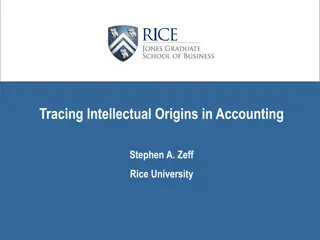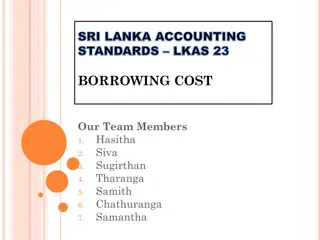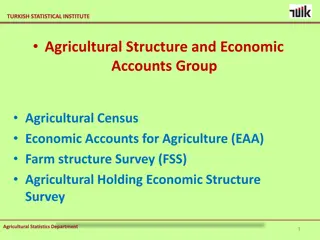Accounting for Biological Assets and Agricultural Produce (LKAS 41: Agriculture) by Rangajewa Herath
This content provides insights into the accounting standards for biological assets and agricultural produce under LKAS 41, discussing classification, presentation, measurement, gain or loss recognition, and disclosure requirements. It covers the unique nature of biological assets, the scope of LKAS 41, agricultural activities, and the nature of biological assets and agricultural produce.
- Accounting standards
- Biological assets
- Agricultural produce
- Financial statements
- Disclosure requirements
Download Presentation

Please find below an Image/Link to download the presentation.
The content on the website is provided AS IS for your information and personal use only. It may not be sold, licensed, or shared on other websites without obtaining consent from the author. Download presentation by click this link. If you encounter any issues during the download, it is possible that the publisher has removed the file from their server.
E N D
Presentation Transcript
Accounting for Biological Assets and Agricultural Produce (LKAS 41: Agreeculture) Rangajewa Herath B.Sc. Accountancy and Financial Management(Sp.)(USJ) MBA-PIM(USJ)
Main Accounting Issues Since biological assets are unique in nature, do they need a dedicated accounting standard? How should biological assets / agricultural produce be classified and presented in financial statements? How should biological assets /agricultural produce be measured? When and how should the gain or loss arising from fair value changes of biological assets / agricultural produce be recognized? What are the disclosures to be made in relation to biological assets ? Rangajeewa Herath 2
Scope of LKAS 41/ Revised IAS 41 Applied to account for the following when they relate to agricultural activity: a) Biological assets except for bearer plant; b) Agricultural produce at the point of harvest; and c) Government grants covered by Paragraphs 34 and 35. Rangajeewa Herath 3
Agricultural Activity (Paragraph 5) The management by an entity of the biological transformation and harvest of biological assets for sale or for conversion into agricultural produce or into additional biological assets. Biological transformation processes of growth, degeneration, production and procreation that quantitative changes in a biological asset. Harvest is the detachment of produce from a biological asset or cessation of the biological asset s life processes. comprises the cause qualitative or Rangajeewa Herath 4
Agricultural Activity (Contd.) Covers a diverse range of activities Common features exist within this diversity: Capability to change (living animals and plants are capable of biological transformation.) Management of change (enhancing or stabilizing conditions necessary for the process to take place) Measurement of change (change in quality or quantity brought about by biological transformation or harvest) Rangajeewa Herath 5
The Nature of Biological Assets Biological Asset Agricultural Agricultural Produce Produce A living animal or plant. The harvest of the entity s biological assets Rangajeewa Herath 6
Agricultural produce Biological asset Products arise due to processing after harvest Rangajeewa Herath 7
Agricultural produce Biological asset Products arise due to processing after harvest Rangajeewa Herath 8
The Nature of Biological Assets (Contd.) Biological asset Agricultural produce Products arise due to processing after harvest Yarn, Carpet Cheese Logs, Lumber Sheep Dairy cattle Trees in a timber plantation Fruit trees Tea bushes Tobacco plant Grape vines Oil palms Wool Milk Felled Trees Picked fruit Leaf Leaf Grapes Picked Fruit Processed fruit Tea Crude tobacco Wine Palm oil Rangajeewa Herath 9
Bearer Plant Bearer plant is a plant that : Is used in production or supply of agricultural produce; Is expected to bear produce over one accounting period and; has a remote likelihood of being sold as agricultural produce, except for incidental scrap sales. ( Revised IAS 41) Rangajeewa Herath 10
Bearer Plant (Contd.) The following are not bearer plants: plants cultivated to be harvested as agricultural produce (e.g. trees grown for use as lumber); plants cultivated to produce agricultural produce when there is more than a remote likelihood that the entity will also harvest and sell the plant as agricultural produce, other than as incidental scrap sales (e.g. trees that are cultivated both for their fruit and their lumber); annual crops (for example, padddy and wheat). Rangajeewa Herath 11
Unique Characteristics Natural capacity to grow and/or procreate has an impact on value Great deal of increase in value of resulting from the input of free goods Many costs early in the life, economic benefits until many years later Long production (growing cycle) of assets Not necessarily any relationship between the expenditure and ultimate benefits Rangajeewa Herath 12
Recognition (Paragraph 10) An entity shall recognize a biological asset or agricultural produce when and only when: a) The entity controls the asset as a result of past events; b) It is probable that future economic benefits associated with the asset will flow to the entity; and c) The fair value or cost of the asset can be measured reliably. Rangajeewa Herath 13
Measurement Biological Asset Agricultural produce Fair value less costs to sell on initial recognition and at the end of each reporting period except in the case described in Paragraph 30 where fair value can not measures reliably. (Paragraph 12) Fair value less costs to sell at the point of harvest. (Paragraph 12) Rangajeewa Herath 14
Definition Definition - - Fair value (SLFRS 13) Fair value (SLFRS 13) Fair value as the price that would be received to sell an asset or paid to transfer a liability in an orderly transaction between market participants at the measurement date. Particular asset or liability Orderly transaction (not a forced sale) Market participants (market-based view) Price (exit price) Rangajeewa Herath 15
Inability to Measure Fair Value Reliably Presumption - fair value can be measured reliably for a biological asset. If fair value of a biological asset cannot measured reliably - measure at cost less accumulated depreciation and accumulated impairment losses. (Paragraph 30) The presumption in Paragraph 30 can be rebutted only at initial recognition. Rangajeewa Herath 16
Gains and Losses arising from measurement at fair value less costs to sell Biological Assets Agricultural Produce Arising on initial recognition and from change in fair value at the end of reporting period Arising on initial recognition Included in profit or loss for the period in which it arises (Paragraph 28) Included in profit or loss for the period in which it arises (Paragraph 26) Rangajeewa Herath 17
Disclosure (Paragraphs 40 to 57) Description of each group of biological assets. Quantitative description of each group of biological assets. - between mature and immature biological assets -between consumable and bearer biological assets ( applicable for Livestock) Rangajeewa Herath 18
Disclosure (Contd.) Harvested as agricultural produce or sold as biological assets. (e.g. livestock held for sale or livestock held for the production of meat) Consumable biological assets Not agricultural produce but, rather, held only for bearer produce. (e.g. livestock from which milk is produced) Bearer biological assets Attained harvestable specifications (for consumable biological assets) or sustain regular harvest (for bearer biological assets). Mature biological assets Rangajeewa Herath 19
Summary Unique characteristics of biological assets Resulting accounting issues Addressing those issues through LKAS 41 -Agriculture Rangajeewa Herath 20























